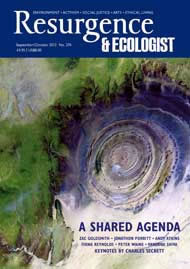Known for their beauty, aspens have been in decline across North America, with some dramatic losses in recent years. Aware of the rapid growth of radiofrequency (RF) radiation, particularly from mobile-phone ‘towers’, Colorado researcher Katie Haggerty had an inspiration: she planted three test plots of aspen seedlings. Carefully matched in all other respects, one plot was shielded from a nearby town’s RF radiation, one was ‘mock’ shielded, and the other was left unprotected. The difference, recorded in the International Journal of Forestry Research, was startling: the fully shielded saplings were vigorous and healthy, but both the ‘mock’ shielded and the exposed plants were small, lacked pigments, and had sickly leaves.
Such studies are but whispers on the wind compared to the billion-pound clamour of marketing campaigns telling us: “You must have smartphones!” (Must we?) “You can’t live without them!” (Really?)
Across the Atlantic, Spanish biologist Alfonso Balmori of the Institute for the Environment (Consejería de Medio Ambiente) in Castilla y León was conducting a sensitive study of tadpoles. Sited 140m from a set of phone masts, those shielded from its radiation developed normally and in sync; but the unshielded tadpoles grew unevenly, and only 10% survived.
In Switzerland, the University of Zurich’s Michael Hässig recorded multiple cataracts in calves near masts, whilst Belgian researcher Joris Everaert of the Research Institute for Nature and Forest (INBO) mapped striking declines in house sparrows in fields that contained masts. Anil Kumar of the Department of Environmental Science at the University of Jammu in Kashmir, and Sukhdev Dongre of Jayvanti College in Betul, Madhya Pradesh echoed his findings.
Meanwhile, Marie-Claire Cammaerts and her team at the Université Libre in Brussels studied the effects of a weak signal on ant colonies and discovered that they became confused to such an extent that they no longer remembered the cues that led them to food.
Riding winter A-roads fringed with trees, I noticed ‘cell towers’ struck through them with stark regularity. Steel trees, they are skeletal among the living. Unlike the passive ‘dead forms’ that poet and artist David Jones once described, they are an active force. In the words of Balmori, informed by his years of research, “the electromagnetic field is a perfect secret agent: you cannot see it, you cannot smell it, you cannot hear it, you cannot feel it, and its effects are slow but relentless.”
To grasp ‘everything everywhere’, we are losing our last clean habitats to microwave pollution. The breathing spaces once free of mobile-phone signals are closing. Already irradiated with 2G and 3G from phone towers, we now face 4G: a quick-fix substitute for clean fibre-optic broadband. To insist on mobile broadband, even in the semi-wild, is to assent to a subtle pollution of every cell in our bodies and the community of life with which we share the planet. Equally, the harsh mines and production lines behind many phones and tablets shame us all.
Ten years ago, a knee problem compelled me to carry very little. I would travel with barely more than a bus fare in my pocket. While friends succumbed to mobile-phone anxiety, forever checking for messages and afraid they would lose their phones, I was carefree. Messages could wait. Then two years ago (still phone-free), I fell deeply ill. It was as swift and mysterious as the aspen decline: month after month was void of sleep, with dizzy, brain-burnt days. No herb or prescription brought relief, and nor did CBT (cognitive behavioural therapy). Bewildered with exhaustion, and having lost my job, I began to question the presence of technology in my life. When had Wi-Fi arrived in my workplace? Answer: just before the illness, and just before Wi-Fi arrived in our house.
Intrigued, and knowing that Wi-Fi uses pulsed microwaves, I hired an acoustic detector. Sure enough, Wi-Fi’s fierce pulse could be heard throughout our house. When it was switched off, though my dizziness eventually began to ease, what remained was the high, scraping whine of mobile-phone towers. Shockingly, the highest microwave radiation was in our bedroom.
I took immediate action. By night – and just like Haggerty’s aspens – I shielded myself in a metallic mesh; the detector fell silent. I slept like an infant. Even better. Years of poor-quality sleep, followed by none, simply melted away.
My ‘cage’ mimicked the world we were born into – when human beings first walked the Earth, singing their praise to the stars, background radiation was low. Today, in the words of Olle Johansson of the Karolinska Institute in Sweden, “you are sitting in levels (3G) that are approximately one million billion times above natural background... Therefore you must ask yourself, do we through evolution have a microwave shield built into our bodies? ...of course we don’t.”
Today we walk among what I think of as steel trees: according to action group Mast Sanity there are more than 52,000 masts in the UK, and the number is growing. Transmitters are becoming smaller and more devious. We wade through a sea of microwaves, its currents augmented by Wi-Fi and cordless-phone stands that pollute our neighbours as well as ourselves. And so, not surprisingly, increasing numbers of people are struggling with symptoms.
In Glastonbury, place of pilgrimage and healing, some streets are ‘gripped’ in a microwave wi-mesh, which has even driven homeowners to sell up to escape this hidden pollution. Stephen Kane and his wife were stricken with “splitting headaches...nausea, insomnia, dripping sweat” and soon discovered that two-fifths of their neighbours were likewise affected. Similarly, householders in America have been fleeing pulsed-microwave smart meters: the insomnia, headaches and heart arrhythmia these can trigger have sent some people to the law courts, and others to the hills.
Is our memory so short that we have forgotten the science of the 1960s, and the Cold War, when microwave sickness from similar ‘low’ levels was relatively well known? Former British military physicist Barry Trower has come out of retirement to warn against meshes; and Karl Hecht, a neurophysiologist at Humboldt University in Berlin and veteran translator of over 800 Russian research papers, views today’s radiation with deep disquiet: in it he sees the pursuit of profit at the expense of bio-wisdom, a slow-drip stress on our bodies’ cells.
Metaphorically, what could be more ‘Gaia’ than the living cells in our own bodies? Aren’t these cells part of her garment, her shifting being?
At the University of Washington in Seattle in 1995, microbiologists Henry Lai and Narendra Singh exposed human cells to a weak microwave signal. Magnitudes below current safety levels set by the International Commission on Non-ionizing Radiation Protection showed a comet-tail of DNA damage streaming from each cell. Today, many international teams have witnessed similar effects (breakages, failed transcriptions, delays in repair), as well as altered gene expression, seen for example in a Munich-based study by Franz Adlkofer. Indeed, studies conducted by radiobiologist Dimitris Panagopoulus at the University of Athens found that fruit flies exposed even to weak fields of radiation suffered DNA damage and infertility.
With current cancer rates, we should be asking: is it wise to emit pulsed microwaves so routinely? And if the answer is no, then what is the alternative?
One simple solution is to return to the use of cable. (Many laptops and tablet computers can use ethernet; telephone landlines can take our bulk calls.) Following reports of health problems, a number of French libraries have swapped Wi-Fi for cabled internet. Others have binned cordless-phone stands: health researcher Magda Havas of Trent University, Ontario discovered that the non-stop pulsed microwaves they emit can disturb the heartbeat.
Similarly, Hermann Stever and Jochen Kuhn of the University of Koblenz-Landau found that few honeybees returned to hives exposed to microwave signals, and a small Dutch study at Wageningen University noted bark lesions and leaf death in ash trees next to routers.
But what of the steel forest we would be left with? Though industry dismisses any concerns as fantasy, a team led by Patrizia Frei at the University of Basel in 2009 found that cumulative exposure from urban cell-towers was higher on average than that from mobile phones themselves. And many researchers have noted increased headaches, poor sleep and other problems in families living near them. Though brief lab studies quite often find no ill effects, this does not rule out chronic influences – Klaus Buchner of the Technical University at Munich, and Emad Eskander, an endocrinologist at the National Research Centre in Cairo, each found long-term hormonal imbalances in people living near new or existing masts. And even more ominously, when environmental engineer Adilza Dode of the University of Minas Gerais scrutinised public health records in Brazil, she found that cancer deaths increased sharply with local mast density – it seems this could not be explained away – whilst in Israel, physiologist Ronni Wolf of Tel Aviv University documented triple and quadruple cancer rates in their near fields.
Though the European Environment Agency has called for less exposure and far more caution, such wisdom is lost in the stampede. Insects, plants, birds, ourselves: we are all caught in a vast experiment from which there is little escape. Isn’t it time to decry this and rebel? To seed and share awareness? Starting now.







